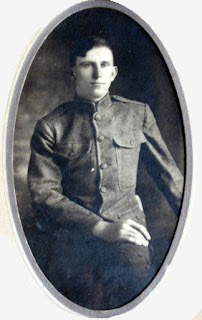 |
| [TRANSCRIPT] |
Rudolph arrived at Camp Cody, near Deming, New Mexico by train in August 1918. Camp Cody was one of numerous training camps created nationwide beginning in May 1917. Sixteen National Army cantonments included Camp Dix, Wrightstown, New Jersey; and Camp Travis, San Antonio, Texas. Sixteen National Guard camps included Camp Bowie, Fort Worth, Texas; Camp Logan, Houston, Texas; and Camp Cody. These camps were quickly erected with wood frame barracks, quarters, administrative buildings, hospitals, warehouses, kitchens and mess halls, plus tents on wooden platforms for most of the trainees.
 Why Rudolph was sent to far away New Mexico instead of San Antonio, Houston or Fort Worth is unclear. Other newspapers reported new draftees heading to these camps. One report about a few Texas soldiers being sent to Camp Cody speculated that there were bunks needing to be filled. What is clear is that in time of war the National Guard was merged with the Regular Army and Army Reserves. All were serving the Army of the United States.
Why Rudolph was sent to far away New Mexico instead of San Antonio, Houston or Fort Worth is unclear. Other newspapers reported new draftees heading to these camps. One report about a few Texas soldiers being sent to Camp Cody speculated that there were bunks needing to be filled. What is clear is that in time of war the National Guard was merged with the Regular Army and Army Reserves. All were serving the Army of the United States.
Rudolph mentioned "That Kruger boy from Taylor" who may have been Arthur Krueger mentioned in the Taylor Press article the morning Rudolph was drafted. I have not been able to find a family connection to Arthur even though Rudolph married into the Andrew Krueger family after the war. Arthur may have been from the Frederich Krueger family, which is more distantly related. He also mentions "Carter from Beaukiss", who may have been Silas Carter, who also traveled from Taylor with him.
"Casual Camp" was apparently a temporary quarantine area for brand new soldiers to minimize influx if illness and to sort out which ones were best suited for different military assignments. The army's program for managing health is also reflected in his comment about getting his first (vaccination) shot.
Rudolph asked Ella how they were getting along with picking. Like most farming families in eastern Williamson County, the Beyer family grew cotton on their farm of more than 240 acres, purchased as undeveloped land and cleared by hand.
I can't imagine that Rudolph had traveled much before this time. There was much work to do on the farm. Although photos show that the Beyers may have had an automobile by then, this was the time of the Model T Ford, which was limited to about 45 miles per hour. Horse and mule power were still common, especially on farms. He wrote, "I wish you could see this country once . . . ." He clearly enjoyed seeing new places, even as the landscape dried up as he was transported west to New Mexico.












